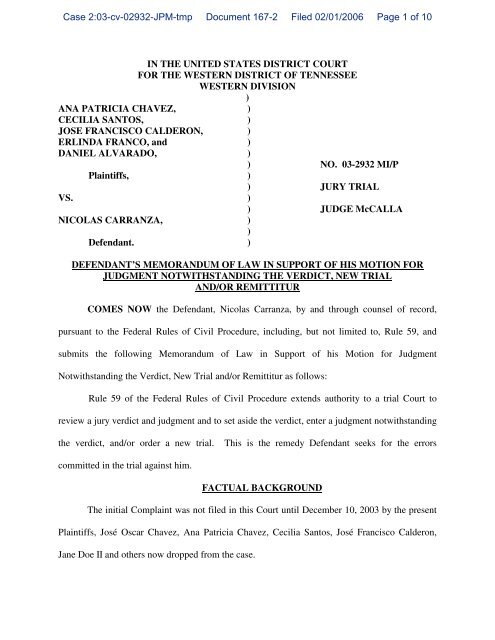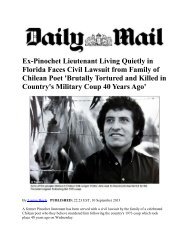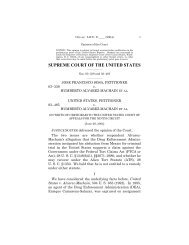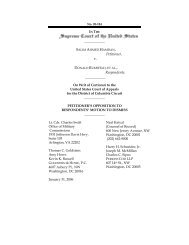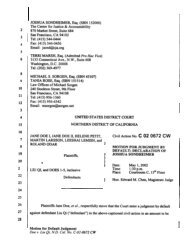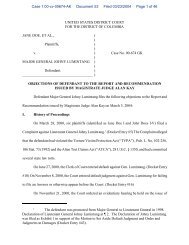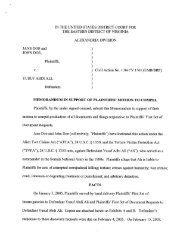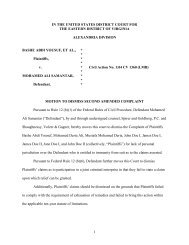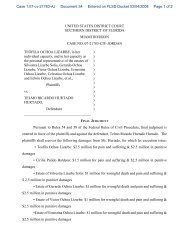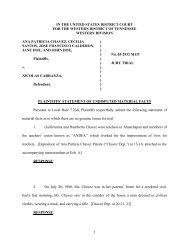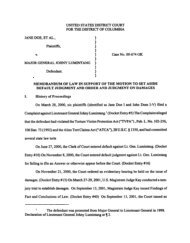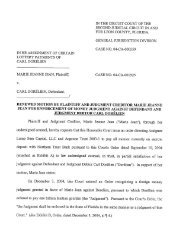Defendant's Memo In Support of Motion for Judgment ...
Defendant's Memo In Support of Motion for Judgment ...
Defendant's Memo In Support of Motion for Judgment ...
- No tags were found...
Create successful ePaper yourself
Turn your PDF publications into a flip-book with our unique Google optimized e-Paper software.
Case 2:03-cv-02932-JPM-tmp Document 167-2 Filed 02/01/2006 Page 1 <strong>of</strong> 10IN THE UNITED STATES DISTRICT COURTFOR THE WESTERN DISTRICT OF TENNESSEEWESTERN DIVISION)ANA PATRICIA CHAVEZ, )CECILIA SANTOS, )JOSE FRANCISCO CALDERON, )ERLINDA FRANCO, and )DANIEL ALVARADO, )) NO. 03-2932 MI/PPlaintiffs, )) JURY TRIALVS. )) JUDGE McCALLANICOLAS CARRANZA, ))Defendant. )DEFENDANT’S MEMORANDUM OF LAW IN SUPPORT OF HIS MOTION FORJUDGMENT NOTWITHSTANDING THE VERDICT, NEW TRIALAND/OR REMITTITURCOMES NOW the Defendant, Nicolas Carranza, by and through counsel <strong>of</strong> record,pursuant to the Federal Rules <strong>of</strong> Civil Procedure, including, but not limited to, Rule 59, andsubmits the following <strong>Memo</strong>randum <strong>of</strong> Law in <strong>Support</strong> <strong>of</strong> his <strong>Motion</strong> <strong>for</strong> <strong>Judgment</strong>Notwithstanding the Verdict, New Trial and/or Remittitur as follows:Rule 59 <strong>of</strong> the Federal Rules <strong>of</strong> Civil Procedure extends authority to a trial Court toreview a jury verdict and judgment and to set aside the verdict, enter a judgment notwithstandingthe verdict, and/or order a new trial.This is the remedy Defendant seeks <strong>for</strong> the errorscommitted in the trial against him.FACTUAL BACKGROUNDThe initial Complaint was not filed in this Court until December 10, 2003 by the presentPlaintiffs, José Oscar Chavez, Ana Patricia Chavez, Cecilia Santos, José Francisco Calderon,Jane Doe II and others now dropped from the case.
Case 2:03-cv-02932-JPM-tmp Document 167-2 Filed 02/01/2006 Page 2 <strong>of</strong> 10The first Amended Complaint was filed on February 23, 2004, which added John Doe asa Plaintiff.A second Amended Complaint has just been filed on June 22, 2005, which does not addany additional parties, but removes original Plaintiffs Haydee Duran, Jose Oscar Chavez andJane Doe I from the lawsuit.With regard to the remaining Plaintiffs, Ana Patricia Chavez brings her claim on two (2)events that occurred on July 26, 1980.Ana Patricia Chavez has been a resident <strong>of</strong> Cali<strong>for</strong>nia and a legal permanent resident <strong>of</strong>the United States since 1980.The original Plaintiff, Cecilia Santos, is a resident <strong>of</strong> the State <strong>of</strong> New York and anaturalized citizen <strong>of</strong> the United States. She has resided in the United States since June <strong>of</strong> 1983.Her claims are based on occurrences that occurred in 1982.The original Plaintiff, José Francisco Calderon, is a resident <strong>of</strong> San Francisco, Cali<strong>for</strong>nia,and a naturalized citizen <strong>of</strong> the United States. He has resided in the United States since February<strong>of</strong> 1981. His claims are based on occurrences that took place in September <strong>of</strong> 1980.The original Plaintiff, Jane Doe II, is the only party to the lawsuit that still resides in ElSalvador. Her claims are based on occurrences that occurred in November <strong>of</strong> 1980.The Plaintiff, John Doe, who became a party to the lawsuit in February <strong>of</strong> 2004 in thefirst Amended Complaint, is a resident <strong>of</strong> Sweden, having moved and resided there since 1986.His claims are based on occurrences that took place in 1983.The Plaintiffs claims against the Defendant are made pursuant to the Torture VictimProtection Act, (Pub. L. 102-256, 106 Statutes 73) 1992 and the Alien Tort Claims Act, 28U.S.C. § 1350.25514 2
Case 2:03-cv-02932-JPM-tmp Document 167-2 Filed 02/01/2006 Page 3 <strong>of</strong> 10STATUTORY BAR/LACHES/ESTOPPEL1. The Claim Is Barred By The Statute Of LimitationsThe relevant statute <strong>of</strong> limitations is contained in what is commonly known as the“Torture Victim Protection Act” <strong>of</strong> 1991 also codified in 28 U.S.C. §1350. Section 2(c) clearlystates the Statute <strong>of</strong> Limitations, which is as follows:“No action shall be maintained under this section unless it iscommenced within ten (10) years after the cause <strong>of</strong> action arose.”The claims <strong>of</strong> the Plaintiffs recited in the complaint clearly occurred well over twenty(20) years prior to the commencement <strong>of</strong> this action in Federal Court. Consequently, no cause <strong>of</strong>action exists on the part <strong>of</strong> the Plaintiffs against the Defendant, Nicolas Carranza, because theywere not timely made. The Defendant contends that the lawsuit filed against him has not beentimely made and, <strong>for</strong> that reason, is barred by the Statute <strong>of</strong> Limitations.The Defendant states that the claims <strong>of</strong> the Plaintiffs, if any, are barred by the appropriateStatute <strong>of</strong> Limitations concerning such allegations and alleged claims, pursuant to “TortureVictims Protection Act <strong>of</strong> 1991" (Pub. L. 102-256 March 12, 1992, 106 Statute 73), which limitsclaim to ten (10) years after the cause <strong>of</strong> action arose which complaint shows on its face that theacts complained <strong>of</strong> accrued in 1979-1980 and are barred.<strong>In</strong> addition, he contends that the Plaintiffs’ causes <strong>of</strong> action are otherwise barred by theDoctrine <strong>of</strong> Comity between nations and the Doctrine <strong>of</strong> According in Full Faith and Credit tothe acts and laws <strong>of</strong> other sovereign nations.The Defendant, Nicolas Carranza, filed a pretrial a <strong>Motion</strong> to Dismiss, and a <strong>Motion</strong> <strong>for</strong>Summary <strong>Judgment</strong> and trial motions <strong>for</strong> Directed Verdict at the end <strong>of</strong> the Plaintiffs’ pro<strong>of</strong> andat the end <strong>of</strong> the introduction <strong>of</strong> evidence based upon the Statute <strong>of</strong> Limitations within which thePlaintiffs had legal causes <strong>of</strong> action and, in addition, the Doctrine <strong>of</strong> Comity and the Doctrine <strong>of</strong>25514 3
Case 2:03-cv-02932-JPM-tmp Document 167-2 Filed 02/01/2006 Page 4 <strong>of</strong> 10Full Faith and Credit, which the Courts <strong>of</strong> the United States <strong>of</strong> America should accord to thelaws <strong>of</strong> the sovereign nation <strong>of</strong> El Salvador.The Court erred by failing to apply the statutory bar and sustain the Defendant’s <strong>Motion</strong>sto Dismiss and Rule 56 <strong>of</strong> the Federal Rules <strong>of</strong> Civil Procedure <strong>Motion</strong> <strong>for</strong> Summary <strong>Judgment</strong>,which should have been sustained since there were no material issues <strong>of</strong> material fact, or law thatwould support any <strong>of</strong> the Plaintiffs’ claims.The learned Trial Judge found that the fear <strong>of</strong> Plaintiffs to file a lawsuit as alleged inPlaintiffs’ Amended Complaint and Affidavits in Opposition to Defendant’s <strong>Motion</strong> <strong>for</strong>Summary <strong>Judgment</strong> was sufficient to toll the statute <strong>for</strong> more than ten (10) years.However, at the trial <strong>of</strong> the case, all <strong>of</strong> the Defendants stated they did not know theycould file a lawsuit until contacted by lawyers from the Center <strong>for</strong> Justice and Accountability,who solicited each <strong>of</strong> them to pursue claims against Nicolas Carranza specifically.Those facts beg the questions…”How can a person fear what they do not even know theyhave a right to?” and “How can the Doctrine <strong>of</strong> Equitable Tolling apply to ignorance <strong>of</strong> the law<strong>for</strong> which there is usually no excuse, as well as, known maxim <strong>of</strong> law?”The claims <strong>of</strong> the Plaintiffs are barred under the sovereign laws <strong>of</strong> the nation <strong>of</strong> ElSalvador, where the alleged causes <strong>of</strong> action accrued and that the United States <strong>of</strong> Americashould give full faith and credit to the sovereign legal laws <strong>of</strong> the nation <strong>of</strong> El Salvador by reason<strong>of</strong> the accord <strong>of</strong> nations and comity between nations and the common law doctrine <strong>of</strong> full faithand credit adhered to by the United States <strong>of</strong> America and recognized in the Constitution <strong>of</strong> theUnited States <strong>of</strong> America, which precludes the causes <strong>of</strong> action alleged and claimed by the eachPlaintiff.25514 4
Case 2:03-cv-02932-JPM-tmp Document 167-2 Filed 02/01/2006 Page 5 <strong>of</strong> 10There is no question that the El Salvador Peace Accord and Amnesty Law was the result<strong>of</strong> assistance from the United Nations, Western Hemisphere Neighbor Nations, including theUnited States. <strong>In</strong> essence, it was a treaty between differing political groups and was a treaty<strong>for</strong>eclosing legal action against participants in either faction or group.This action ignores the treaty and agreement structured by representatives <strong>of</strong> the UnitedNations and refuses to give value or recognition to it.Plaintiffs’ argued that to do so would make the law a nullity. That is simply not true. Itwould only make it inapplicable to sovereign nations having a treaty or valid agreement, whichEl Salvador had.The Plaintiffs have failed to exhaust their remedies under the laws <strong>of</strong> El Salvador wherethe alleged causes <strong>of</strong> action occurred. The Amnesty Law alleged by the Plaintiffs was notenacted until more than ten (10) years after the occurrences or causes <strong>of</strong> action alleged by thePlaintiffs occurred and they have not pled any facts about actions taken against the Defendant inEl Salvador but simply make the conclusionary statement that the Amnesty Law <strong>for</strong>eclosed theiralleged claims or causes <strong>of</strong> action.HEARSAY EVIDENCEThe Defendant contends that the trial Court erred by admitting hearsay evidence that waswithout any legal basis <strong>for</strong> admission pursuant to Plaintiffs’ counsel’s erroneous reliance uponthe exceptions to the hearsay Rule <strong>for</strong> “ancient documents” and “public records”. The Plaintiffs’witnesses Robert White and Terry Karl represented to the jury that a highly redacted andunsigned document was allegedly prepared by Brian Bosch, as the <strong>for</strong>mer U.S. military attachéand that he represented that the Defendant agreed with the killing <strong>of</strong> six (6) FDR leaders.Defense counsel has now located Attaché Bosch and he has prepared an affidavit denying the25514 5
Case 2:03-cv-02932-JPM-tmp Document 167-2 Filed 02/01/2006 Page 6 <strong>of</strong> 10contents and truth <strong>of</strong> the statements therein and further denying that he prepared the document.The Court allowed this type <strong>of</strong> highly inflammable hearsay evidence regarding acts by unknownthird parties, including but not limited to, guerillas, members <strong>of</strong> the military and revolutionariesfrom other countries. Additionally, the Court allowed highly inflammatory evidence <strong>of</strong> horribleconduct and crimes that took place years after the Defendant was no longer associated with theEl Salvador military and even after the Defendant had been moved out <strong>of</strong> the country <strong>for</strong> severalyears.admissible:Rule 401 <strong>of</strong> the Federal Rules <strong>of</strong> Evidence states:“’Relevant evidence’ means evidence having any tendency to make theexistence <strong>of</strong> any fact that is <strong>of</strong> consequence to the determination <strong>of</strong> theaction more probable or less probable than it would be without theevidence.”Rule 402 <strong>of</strong> the Federal Rules <strong>of</strong> Evidence states that irrelevant evidence is not“All relevant evidence is admissible except as otherwise provided by theConstitution <strong>of</strong> the United States, by act <strong>of</strong> Congress, by these Rules, or byother rules prescribed by the Supreme Court, pursuant to statutoryauthority. Evidence which is not relevant is not admissible.” [emphasisadded]Rule 403 <strong>of</strong> the Federal Rules <strong>of</strong> Evidence provides <strong>for</strong> the exclusion <strong>of</strong> even relevantevidence on the ground <strong>of</strong> prejudice, confusion or waste <strong>of</strong> time and states the following:“Although relevant, evidence may be excluded if its probative value issubstantially outweighed by the danger <strong>of</strong> unfair prejudice, confusion <strong>of</strong>issues, or misleading the jury, or by consideration <strong>of</strong> undue delay, waste <strong>of</strong>time or needless presentation <strong>of</strong> cumulative evidence.”TWELVE PERSON JURYThe Defendant believes that the case <strong>of</strong> Colgrove v. Battin (1973) 413 U.S. 149, 93 S.Ct.2448, 37 L.Ed. 2d 522 is a case that deals with the subject matter involved in the <strong>Motion</strong>. The25514 6
Case 2:03-cv-02932-JPM-tmp Document 167-2 Filed 02/01/2006 Page 7 <strong>of</strong> 10Defendant does not contend that he has an exclusive right to demand twelve (12) jurors to try hiscase but, on the other hand, contends that the trial court has discretion and authority to permittwelve (12) jurors to sit as jurors and decide the case on the law and evidence. Juries <strong>of</strong> less thantwelve (12) are discretionary with the court.Federal Rule <strong>of</strong> Civil Procedure, Rule 48, provides <strong>for</strong> the number <strong>of</strong> jurors participatingin a verdict and states the following:“The Court shall seat a jury <strong>of</strong> not fewer than six and not more thantwelve members and all jurors shall participate in the verdict unlessexcused from service by the Court pursuant to Rule 47(c). Unless thePlaintiffs otherwise stipulate, (1) the verdict shall be unanimous and (2)no verdict shall be taken from a jury reduced in size to fewer than sixmembers.”Consequently, the Defendant contends that the Court has the authority and the discretionto impanel a jury <strong>of</strong> twelve (12) jurors to decide the case by unanimous verdict.ABSENCE OF PROXIMATE CAUSEWhile the Defendant, Nicolas Carranza, cannot <strong>of</strong>fer detailed evidence that the Plaintiffsare not telling the truth, he has again raised the issue <strong>of</strong> due process in view <strong>of</strong> the fact that theevents alleged occurred over twenty (20) years ago, during which time he has resided in theUnited States and has been a resident <strong>of</strong> the United States.The Plaintiffs concede that the Defendant Carranza was not a perpetrator <strong>of</strong> the injuriesand harm claimed by the Plaintiffs and the essential ingredient <strong>of</strong> the claim <strong>of</strong> the Plaintiffsseems to be that Carranza was aware <strong>of</strong> the acts and did not investigate the claims <strong>of</strong> thePlaintiffs, find the malefactors and have them prosecuted. That raises an interesting question.The claims made by the Plaintiffs under the ATCA and TVPA are essentially tort claims<strong>for</strong> damages due to the bodily harm or injurious effect <strong>of</strong> conduct. See Usarei v. Rio Tinto PLC(C.D. CAL 2002) 221 F.Supp.1116.25514 7
Case 2:03-cv-02932-JPM-tmp Document 167-2 Filed 02/01/2006 Page 8 <strong>of</strong> 10Since they are tort claims, how could the investigation, discovery and prosecution <strong>of</strong> theperpetrators have prevented the harm already caused? <strong>In</strong> other words, the Plaintiffs are surelynot claiming that the Defendant Carranza had specific scienter and could have preventedoccurrences alleged by <strong>for</strong>eknowledge.Consequently, while the Defendant is not making light <strong>of</strong> what happened to any <strong>of</strong> thePlaintiffs or their relatives, there is in reality no causal connection between the injuries and harmsustained by the Plaintiffs’ claim that, while Carranza was not a participant or perpetrator, he didnot exercise “command” authority and investigate the Plaintiffs’ claims or complaints. Whilethere is no pro<strong>of</strong> that he was aware <strong>of</strong> the Plaintiffs’ complaints, how would that have preventedthe harm and wrong complained <strong>of</strong> by the Plaintiffs in this case. Additionally, it is basic tort lawthat there must be a causal relationship in connection between the act and injury. The injury tothe Plaintiffs, even if known or made known, had already occurred be<strong>for</strong>e an investigation couldbe instituted.SUMMARY JUDGMENT STANDARDSummary <strong>Judgment</strong> “mirrors the standard <strong>for</strong> a directed verdict under Federal Rule <strong>of</strong> CivilProcedure 5 0(a), which is that the trial judge must render verdict if there can be but onereasonable conclusion as to the outcome. Anderson v. Liberty Lobby, <strong>In</strong>c., 477 US 242, 250-51,106 S. CT. 2505, 2511, 91L. Ed 2d 202 (1986). A genuine issue exists where the evidence be<strong>for</strong>ethe Court is <strong>of</strong> such a nature that a reasonable jury could return a verdict in favor <strong>of</strong> thenonmoving party. Id. at 248. The Court must deny summary judgment when a genuine issue <strong>of</strong>material fact exists or where the court concludes that a full or more complete factualdevelopment is necessary. Kennedy v. Silus Mason Company, 334 US 249, 68 S. CT. 1031, 92 L.Ed. 1347 (1948). The Courts role under Rule 56 is merely limited to assessing the threshold issue25514 8
Case 2:03-cv-02932-JPM-tmp Document 167-2 Filed 02/01/2006 Page 9 <strong>of</strong> 10<strong>of</strong> whether a genuine issue exists as to material facts to require a trial. Anderson v. Liberty Lobby477 US at 249. All reasonable inferences must be drawn in favor <strong>of</strong> the nonmoving party. Id at255. Of course, in this diversity case, substantive law <strong>of</strong> the State <strong>of</strong> Tennessee applies in regardto the validity <strong>of</strong> Plaintiff’s claims. Erie R. R. v. Tompkins. 304 US 64 (1938).CONCLUSIONBecause <strong>of</strong> the errors committed against him stated above, the Defendant, NicolasCarranza, respectfully requests that his <strong>Motion</strong>s be granted and that the verdict <strong>of</strong> the jury be setaside and judgment be entered <strong>for</strong> the Defendant or in the alternative that he be granted a newtrial.Respectfully Submitted,COUNSEL FOR DEFENDANTROBERT M. FARGARSON (#8420)BRUCE D. BROOKE (#4521)FARGARSON & BROOKE254 Court Avenue, Suite 300Post Office Drawer 3543Memphis, TN 38173-0543(901) 523-250025514 9
Case 2:03-cv-02932-JPM-tmp Document 167-2 Filed 02/01/2006 Page 10 <strong>of</strong> 10CERTIFICATE OF SERVICEI, Robert M. Fargarson, do hereby certify that a copy <strong>of</strong> the <strong>for</strong>egoing is being served onall Plaintiffs by <strong>for</strong>warding same, via U.S. Mail, postage prepaid and Facsimile Transmission onthis the 1 st day <strong>of</strong> February. 2006, to:David R. Esquivel, Esq. (TN #21459)AmSouth Center315 Deaderick Street, Suite 2700Nashville, TN 37238-3001ROBERT M. FARGARSON25514 10


